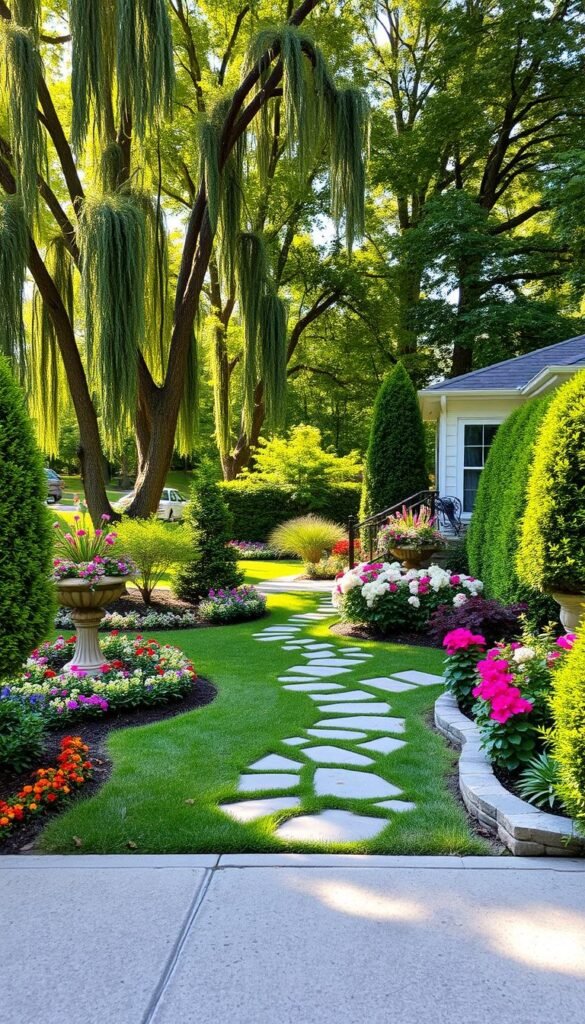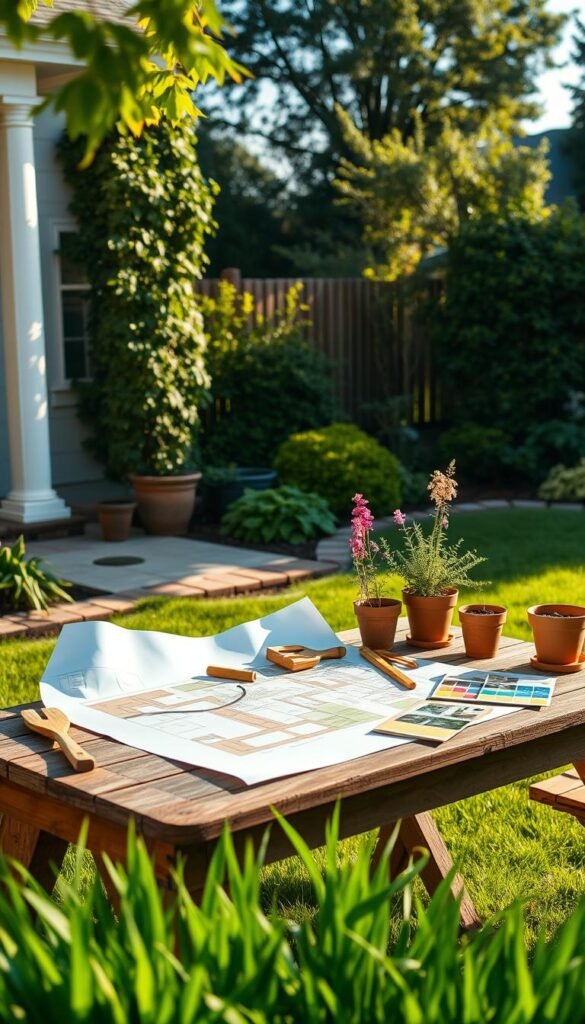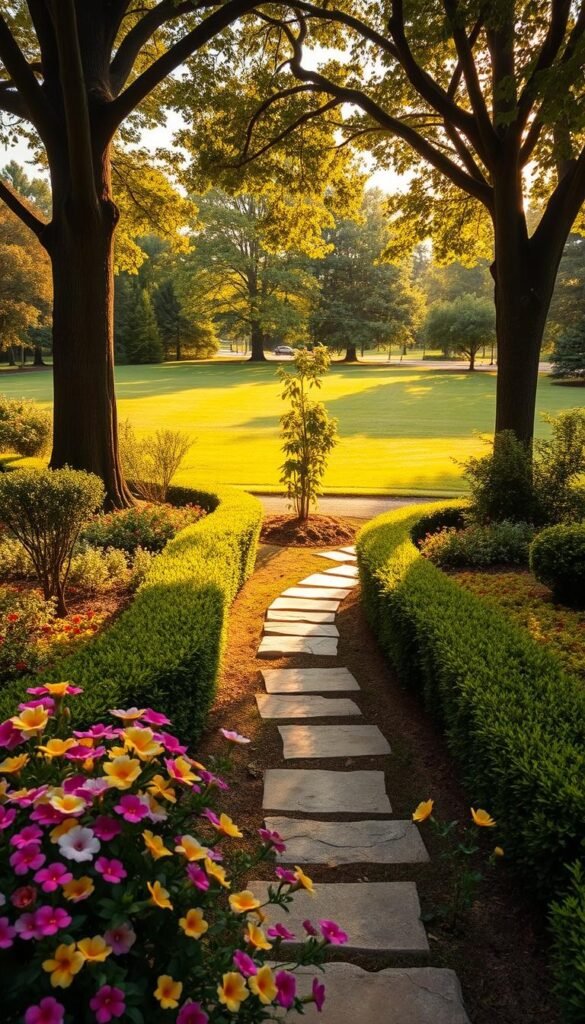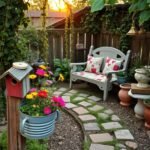Your property’s entrance acts as a visual handshake to guests and passersby. A polished outdoor area doesn’t just showcase your personality—it can increase your residence’s value by up to 20%, according to recent studies. Even modest updates, like refreshing flower beds or adding pathway lighting, create immediate visual impact.
Strategic updates transform ordinary spaces into inviting environments. For example, matching plant colors to your house’s exterior creates harmony, while container gardens near entryways add warmth. These choices influence how others perceive your space—and how you feel coming home each day.
You don’t need endless resources to refresh your exterior. Repainting a front door or trimming overgrown shrubs costs little but delivers dramatic results. As seasonal plant rotations prove, small shifts keep your look vibrant year-round.
Thoughtful arrangements bridge your home’s architecture with nature. A curved walkway softens angular rooflines, while ornamental trees frame windows beautifully. This balance between structure and greenery makes every arrival feel intentional—and unforgettable.
Welcome to Your Front Yard Transformation

Creating an inviting exterior starts with understanding the power of first impressions. Your outdoor space acts as a silent ambassador, shaping how others—and even you—experience your residence. Let’s explore how thoughtful updates can elevate both aesthetics and emotional resonance.
Understanding the Importance of Curb Appeal
Great exteriors do more than look pretty—they spark joy. Research shows attractive landscapes can boost a home’s perceived value by 5-11%. But the real magic? How a vibrant yard makes neighbors pause and friends feel instantly welcome.
How Small Changes Make a Big Impact
You don’t need grand gestures to refresh your space. Try these budget-friendly ideas:
- Swap faded house numbers for modern metal designs
- Edge walkways with solar-powered stake lights
- Refresh mulch around existing shrubs for instant polish
Even adding a single statement planter by your door creates focal points. The key? Work with what you have. Trimmed hedges and clean pathways often reveal hidden potential, letting your home’s charm shine through.
Planning Your Front Yard Makeover

A well-planned landscape evolves from understanding your space’s potential. Start by sketching your property’s layout—even a rough drawing helps visualize possibilities. Note where paths, trees, or structures already exist. This groundwork saves time and money later.
Assessing Your Outdoor Space
Grab a tape measure and document your yard’s exact dimensions. Mark sunny areas for flowers that crave light, and shady spots for hostas or ferns. Existing trees? Their mature size affects planting choices. “A mature oak’s roots can extend three times its branch span,” notes landscape architect Julie Moir Messervy.
Evaluate hardscape elements like walkways or walls. Could aged pavers be pressure-washed instead of replaced? Sometimes refreshing beats removing. This approach keeps costs low while honoring your home’s history.
Setting Goals, Budget, and Timeline
Ask: “How do I want to use this space?” Entertaining? Low maintenance? Align plans with daily life. Break projects into phases—maybe fix drainage issues before adding decorative gravel.
Create a realistic budget. Allocate 60% to essential landscaping, 25% to plants, and 15% for surprises. Pro tip: Source materials locally to cut delivery fees. Many nurseries offer seasonal discounts on perennials.
Timing matters. Schedule tree planting in fall for stronger roots. Save painting projects for dry spring days. With smart pacing, your vision unfolds smoothly—no overwhelm.
Creating a Design Plan That Reflects Your Style
Your outdoor space becomes a canvas when you start planning its transformation. Whether sketching on grid paper or using apps like iScape, visualizing your layout helps balance practicality with creativity. This approach ensures every element serves a purpose while expressing your unique flair.
Mapping Your Layout and Focal Points
Begin by marking existing features like walkways or mature trees. Then layer in new elements—perhaps a rock garden near the porch or hydrangeas framing the driveway. Pro tip: Use colored pencils to differentiate plant zones from hardscape areas.
Identify one showstopping element to anchor your space. A cobalt-blue planter overflowing with golden marigolds creates instant drama. For year-round interest, mix ornamental grasses with seasonal blooms like petunias or pansies.
Choosing Color and Material Schemes
Coordinate your palette with your home’s exterior. If you have brick accents, echo those hues in flowering shrubs or decorative gravel. “Three-toned schemes work best,” suggests Denver landscaper Rosa Guerrero. “Dominant, secondary, and accent colors create visual flow.”
Select materials that withstand local weather while complementing your architecture. Permeable pavers prevent puddles in rainy regions, while sandstone stays cool underfoot in hot climates. Blend textures—smooth river rocks against rough-hewn timber benches—for tactile appeal.
Essential Landscape Elements for a Stunning Look

The foundation of any memorable outdoor space lies in its core components. Balancing living plants with functional materials creates harmony while solving practical needs. Let’s explore how these pieces work together to build a cohesive, eye-catching environment.
Incorporating Trees, Shrubs, and Flower Beds
Mature trees act as living sculptures, providing shade and framing your property. Choose species like red maples or dogwoods that suit your climate. Their canopy spread determines placement—keep them 15+ feet from foundations to prevent root issues.
Shrubs offer year-round structure. Boxwoods create crisp borders, while hydrangeas add summer blooms. Mix evergreen and deciduous varieties for winter interest. For flower beds, layer plants by height: tall sunflowers at the back, mid-size coneflowers in the middle, and creeping phlox along edges.
| Plant Type | Key Benefit | Ideal Placement |
|---|---|---|
| Japanese Maple | Year-round color | Near entryways |
| Lavender | Drought resistance | Along walkways |
| Hostas | Shade tolerance | Under trees |
Addition of Ground Covers and Mulch
Low-growing plants like creeping thyme fill gaps between stepping stones while releasing fragrance when stepped on. For sloped areas, try erosion-control champions like periwinkle. These living carpets reduce mowing by up to 30%.
Organic mulch does triple duty: it conserves water, blocks weeds, and feeds soil as it breaks down. Refresh bark chips annually in spring. For a whimsical touch, consider cottagecore-inspired ground covers like chamomile lawns or clover patches.
Pair practical solutions with visual appeal. Stone mulch works well in fire-prone regions, while cocoa bean hulls smell divine—just keep them away from pets. Your choices protect plants while making every inch count.
Maintaining Your Lawn and Hardscaping Features

A thriving green space requires more than initial planting—it demands consistent care. With smart routines, your outdoor areas stay vibrant while saving you time. Let’s explore how to balance beauty and practicality through targeted upkeep.
Mastering Year-Round Care
Healthy grass starts with sharp mower blades. Set your cutting height to 3 inches—this shades soil to prevent weeds. Water deeply twice weekly instead of daily sprinkles. “Morning irrigation reduces evaporation by 40%,” notes University of Florida turfgrass expert Dr. Bryan Unruh.
Overseed thin patches in early fall using drought-resistant varieties like tall fescue. Pair this with core aeration to break compacted soil. Your lawn will absorb nutrients better, leading to thicker growth by spring.
| Task | Best Time | Key Benefit |
|---|---|---|
| Aeration | Early Fall | Improves root depth |
| Fertilization | Spring & Fall | Boosts color |
| Mulch Refresh | Late Spring | Controls weeds |
Refresh mulch around trees and flower beds annually. A 2-inch layer keeps soil temperatures stable and reduces watering needs. For hardscape features, pressure-wash stone paths every April and October. Seal cracks in retaining walls before winter to prevent ice damage.
Consistency protects your landscaping investment. Simple habits—like raking leaves promptly or trimming shrubs monthly—keep your home’s exterior inviting. Pair these efforts with seasonal checklists to stay ahead of issues.
Creative Walkway and Outdoor Living Ideas

Pathways do more than guide footsteps—they set the tone for your entire property. A well-crafted path invites exploration while reflecting your home’s personality. Let’s explore how material choices and smart lighting can turn functional elements into artistic statements.
Innovative Pathway Designs
Ditch basic concrete for materials that tell a story. Flagstone creates rustic charm, while geometric slate tiles suit modern designs. For playful energy, arrange irregular-shaped stones like puzzle pieces. “Mixing textures adds depth,” says Austin landscaper Marco Diaz. “Pair smooth river rocks with rough-hewn bricks for contrast.”
Curved paths soften angular architecture and create anticipation. Use meandering gravel trails to showcase flower beds or specimen trees. Prefer crisp lines? Straight walkways framed by low boxwoods offer timeless elegance. Either way, edge your route with thyme or sedum—these fragrant ground covers thrive underfoot.
Enhancing Spaces with Seating and Lighting
Solar-powered lights along walkways serve dual purposes: they prevent nighttime stumbles and cast magical glows. Install warm-white LEDs to highlight textured walls or tree canopies. For cozy spaces, tuck a bench under a pergola draped in wisteria.
Your front porch becomes an instant hangout spot with these upgrades:
- Add a swing with weather-resistant cushions
- Mount pendant fixtures above seating areas
- Use lanterns with flicker bulbs for vintage appeal
These touches extend living areas outdoors, turning your entrance into a destination rather than just a passageway.
Maximizing Small Front Yards with Clever Design
Compact outdoor areas offer big opportunities when approached strategically. By focusing on vertical growth and multi-purpose features, you can craft an inviting environment that feels spacious rather than cramped. Let’s explore solutions that turn limitations into creative advantages.
Vertical Gardening and Container Options
Walls and fences become prime real estate in tight spaces. Install trellises with climbing roses or install modular pocket planters for herbs. Stacked containers let you grow tomatoes and basil vertically—perfect for sunny corners. For shady spots, try hanging ferns or philodendrons.
Rotate seasonal plants in movable pots. Summer petunias swap easily with fall mums, while evergreen boxwoods provide winter structure. Pro tip: Use lightweight fiberglass planters for easy rearranging.
| Vertical System | Best Plants | Space Saved |
|---|---|---|
| Wall Pocket Planters | Succulents, herbs | 4 sq ft per panel |
| Tiered Stands | Strawberries, flowers | Up to 65% |
| Espaliered Trees | Apple, pear varieties | 8-10 ft width |
Smart Utilization of Limited Space
Choose features that pull double duty. A bench with hidden storage holds gardening tools, while a tiered planter displays flowers and defines your entryway. Narrow gravel paths lined with dwarf lavender guide visitors without eating up room.
Scale matters. Opt for petite Japanese maples instead of oak trees. Use ground covers like creeping thyme between stepping stones—they handle foot traffic while smelling divine. Add a 2-foot-wide water feature with a recirculating pump for soothing sounds.
Every inch counts. Mount fold-down shelves for potted annuals or install magnetic herb tins on metal fences. These ideas prove small yards can deliver big personality through thoughtful design.
Front Yard Garden Design Tips: Enhancing Curb Appeal with Creative Ideas
A vibrant entrance isn’t just about plants—it’s about crafting a living welcome mat. By blending perennials like coneflowers with annuals such as zinnias, you’ll enjoy nonstop color from spring through fall. This mix ensures your space always feels fresh while saving money on replacements.
Choose colors that complement your home’s exterior. Warm-toned marigolds pop against gray siding, while cool hydrangeas soften red brick. Arrange taller varieties like hollyhocks behind low-growing sedum to create depth. This layering trick makes compact areas feel lush and intentional.
Your local climate dictates which blooms thrive. In dry regions, opt for drought-resistant lavender or yucca. Humid areas? Try hibiscus or ferns. For seasonal flair, rotate pansies in winter and sunflowers in summer. These choices ensure your space remains vibrant year-round.
Personal touches turn generic layouts into signature styles. Add a quirky sculpture among hostas or paint terra-cotta pots in bold hues. These details reflect your personality while boosting curb appeal effortlessly.
Remember: great outdoor spaces evolve. Start small, observe what works, and expand gradually. With smart plant pairings and thoughtful accents, your home’s first impression will leave lasting smiles.






